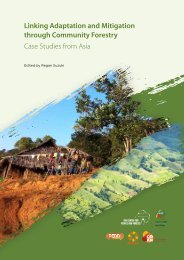Desktop Study on - Regional Climate Change Adaptation ...
Desktop Study on - Regional Climate Change Adaptation ...
Desktop Study on - Regional Climate Change Adaptation ...
You also want an ePaper? Increase the reach of your titles
YUMPU automatically turns print PDFs into web optimized ePapers that Google loves.
<str<strong>on</strong>g>Desktop</str<strong>on</strong>g> <str<strong>on</strong>g>Study</str<strong>on</strong>g><br />
natural variability of climate change. The<br />
estimates should not use average figure but<br />
rather reflect changes in extremes such as<br />
highest water levels, since the seas<strong>on</strong>al and<br />
inter-annual water regime in the Mek<strong>on</strong>g<br />
floodplains and the Tônlé Sap highly varies.<br />
The Tônlé Sap flood pulse system is viewed<br />
critical for sustaining the high aquatic<br />
producti<strong>on</strong> of the lake, and now several different<br />
factors poses a risk <strong>on</strong> chaning the dynamics of<br />
the system. <strong>Climate</strong> change is just <strong>on</strong>e of these<br />
changing factors that affect the TônléSap, and<br />
there exist many other determinant factors<br />
including upstream hydropower development<br />
and local developments within the TônléSap<br />
Basin such as large-scale irrigati<strong>on</strong> projects.<br />
This str<strong>on</strong>gly indicates a need for more holistic<br />
approach where the impacts to the lake system<br />
at different temporal and spatial scales are<br />
assessed comprehensively.<br />
In c<strong>on</strong>sidering the abovementi<strong>on</strong>ed changing<br />
factors <strong>on</strong> flood pulse system, it is also important<br />
to reflect <strong>on</strong> not <strong>on</strong>ly envir<strong>on</strong>mental, but also<br />
social ec<strong>on</strong>omic, instituti<strong>on</strong>al and political<br />
factors that could cause envir<strong>on</strong>mental or<br />
ecological changes. N<strong>on</strong>-envir<strong>on</strong>mental factors<br />
are indeed likely to be much more crucial in<br />
both shorter and l<strong>on</strong>ger term. The different<br />
timescales of impacts from both climatic and<br />
n<strong>on</strong>-climatic factors such as hydropower<br />
development are also essential for the impact<br />
assessment.<br />
There is also lack of knowledge that supports an<br />
appropriate operati<strong>on</strong>al scheme such as real-time<br />
informati<strong>on</strong> about rainfall and water level, flood<br />
forecasts in the wet seas<strong>on</strong> (Watt, 2009 cited in<br />
Solar, 2009). Similarly, the drought management<br />
study of Kyoto University identifies the most<br />
significant deficiencies: the absence of reliable<br />
drought-forecasting mechanisms, the lack of a clear<br />
definiti<strong>on</strong> of drought, and the lack of a c<strong>on</strong>sistent<br />
resp<strong>on</strong>se mechanism. It is suggested to map the<br />
existing capacities of communities and undertake<br />
a l<strong>on</strong>g-term capacity-building programme. It is also<br />
indicated that there is a need for inclusive policymaking<br />
process in which communities, governments<br />
and NGOs jointly make a policy for drought risk<br />
reducti<strong>on</strong>. Community involvement is essential in<br />
designing and implementing drought adaptati<strong>on</strong><br />
practices at the local level.<br />
In additi<strong>on</strong>, as the study <strong>on</strong> the assessment of Mek<strong>on</strong>g<br />
Basin water resource reveals, not much research<br />
and evaluati<strong>on</strong> of the groundwater resources of<br />
the Mek<strong>on</strong>g Basin have been c<strong>on</strong>ducted, including<br />
the volume, discharge/recharge rate and different<br />
use of groundwater and sources, distributi<strong>on</strong> and<br />
impacts of groundwater c<strong>on</strong>taminati<strong>on</strong> (Eastham<br />
et al., 2008). This causes difficulty in quantifying<br />
climate change effects <strong>on</strong> the water sector, leading<br />
to generati<strong>on</strong> of water-borne diseases as well as<br />
unsustainable management of water demand and<br />
supply.<br />
Agriculture and Food Security Sector<br />
Range of Studies Reviewed and<br />
Methods Applied<br />
Cambodia’s agricultural sector is affected by climate<br />
change. The agricultural productivity, for example,<br />
heavily relies <strong>on</strong> the flooding and recessi<strong>on</strong> of<br />
the Tônlé Sap Lake and the Mek<strong>on</strong>g River, which<br />
brings fertile alluviums to the central plains (Royal<br />
Government of Cambodia, 2006). This secti<strong>on</strong><br />
dem<strong>on</strong>strates the positive impacts of climate change<br />
<strong>on</strong> the agricultural productivity, vulnerability of<br />
and potential threats to the agricultural sector,<br />
instituti<strong>on</strong>al resp<strong>on</strong>ses to vulnerability (NAPA), and<br />
several key adaptati<strong>on</strong> strategies implemented by the<br />
government and n<strong>on</strong>-governmental organisati<strong>on</strong>s.<br />
The potential impacts of climate change in the<br />
agricultural sector at the year 2030 were indicated<br />
under the most likely climate c<strong>on</strong>diti<strong>on</strong>s for 2030<br />
assessed based <strong>on</strong> the output of 11 GCMs (Eastham<br />
et al., 2008). The study <strong>on</strong> assessment of climate<br />
change impacts <strong>on</strong> crop yield was c<strong>on</strong>ducted by<br />
using the FAO’s AquaCrop model (Roth, 2009).<br />
Impacts <strong>on</strong> the Agriculture and Food<br />
Security Sector<br />
Eastham et al. (2008) summarises potential impacts<br />
of climate change at the year 2030 <strong>on</strong> catchments of<br />
the Mek<strong>on</strong>g Basin in Cambodia with spatial analysis<br />
of five regi<strong>on</strong>s: Se San (north-east), Kratie (central),<br />
Tônlé Sap (central), Phnom Penh (south-eastern)<br />
and Border (southern) (Roth, 2009). According to<br />
this study, the above-menti<strong>on</strong>ed first three areas<br />
will experience increase in agricultural productivity<br />
and food availability in excess of demand decreased,<br />
although the minimum agricultural area in the<br />
Tônlé Sap may increase. Building <strong>on</strong> the work by<br />
Eastham et al. (2008), the Comm<strong>on</strong>wealth Scientific<br />
and Industrial Research Organisati<strong>on</strong> (CSIRO),<br />
the Mek<strong>on</strong>g River Commissi<strong>on</strong> (MRC) and the<br />
112

















